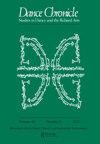“拉尼金斯卡:遗产的揭示与建构”
IF 0.5
3区 艺术学
0 DANCE
引用次数: 0
摘要
“我不希望对女舞者来说存在‘合适’和‘不合适’的传统。每一个动作,如果是新的,都是一个发现”(Nijinska, in Garafola,第54页)。这句话摘自Bronislava Nijinska 1918年的论文,概括了她对芭蕾舞和生活的看法。多年来,学者们为我们提供了Nijinska职业生涯的丰富片段,但她的全部工作尚未得到充分分析。Lynn Garafola的《La Nijinska:现代舞蹈编导》不仅填补了这一空白;从她在圣彼得堡的帝国芭蕾舞学校接受训练到她在基辅发展运动学校,再到她与近20个不同的公司创作了60多部原创作品,这本书提供了一个令人难以置信的全面的艺术干预的描述。《尼金斯卡》内容详尽、内容密集,是芭蕾舞历史学家的参考,并引发了围绕舞蹈评论家的影响和作用、在表演艺术中成为单身职业母亲意味着什么,以及塑造遗产的权力结构等更广泛的讨论。Nijinska的亲生家庭与她作为艺术家的遗产有很大关系。她的哥哥瓦斯拉夫·尼金斯基(Vaslav Nijinsky)启发了她学习舞蹈的方法,并为她打开了职业生涯的大门,但加拉福拉不允许尼金斯基的成功掩盖了尼金斯基的成就。文中几乎没有花时间描写他们的关系,令人耳目一新;确实出现的故事描绘了一个复杂的兄弟姐妹动态。尼金斯基从帝国剧院辞职,开始与俄罗斯芭蕾舞团合作。在那里,他为她编舞,包括《春之祭》(1913)中被选中的少女等主要角色。然而,在她嫁给亚历山大·科切托夫斯基并怀上女儿伊琳娜后,尼金斯基勃然大怒,把她从作品中拉了出来。加拉福拉指出,“把她从她贡献良多的芭蕾舞剧中剔除,是尼金斯基对他妹妹反复出现的残忍行为的另一个例子……”他似乎在惩罚她的女性身体…惩罚她……因为她想要自己的爱情生活,因为本文章由计算机程序翻译,如有差异,请以英文原文为准。
“La Nijinska: Revealing and Constructing Legacy”
“I don’t want the conventions of ‘proper’ and ‘improper’ to exist for the female dancer. Every movement, if it’s new, is a find” (Nijinska, in Garafola, p. 54). Taken from Bronislava Nijinska’s 1918 treatise, this quote epitomizes her outlook, on ballet and life. Over the years, scholars have given us rich snippets of Nijinska’s career, but the entirety of her work has not been fully analyzed. Lynn Garafola’s La Nijinska: Choreographer of the Modern does more than fill this gap; it provides an incredibly thorough account of Nijinska’s artistic interventions from the time she trained with the Imperial Ballet School in St. Petersburg to her developing the School of Movement in Kiev to creating more than sixty original works with nearly twenty different companies. Detailed and dense, La Nijinska functions as a reference for ballet historians, and sparks larger discussions around the influence and role of dance critics, what it means to be a single working mother in the performing arts, and the power structures that shape legacies. Nijinska’s biological family had much to do with her own legacy as an artist. Her older brother Vaslav Nijinsky inspired her approaches to dance and opened professional doors for her, but Garafola does not allow Nijinsky’s success to overshadow Nijinska’s accomplishments. The text refreshingly spends little time on their relationship; the stories that do arise paint a complicated sibling dynamic. Nijinska followed Nijinsky as he resigned from the Imperial Theater and started working with the Ballets Russes. There he choreographed on her, including major roles such as the Chosen Maiden from The Rite of Spring (1913). However, after she married Alexander Kochetovsky and became pregnant with her daughter Irina, Nijinsky became enraged and pulled her out of the piece. Garafola notes that “taking her out of ballets to which she had contributed so much was yet another instance of the cruelty that appears time and again in Nijinsky’s behavior toward his sister . . . he seemed to be punishing her female body . . . chastising her . . . for wanting a love life of her own, for
求助全文
通过发布文献求助,成功后即可免费获取论文全文。
去求助
来源期刊

DANCE CHRONICLE
DANCE-
CiteScore
0.40
自引率
0.00%
发文量
22
期刊介绍:
For dance scholars, professors, practitioners, and aficionados, Dance Chronicle is indispensable for keeping up with the rapidly changing field of dance studies. Dance Chronicle publishes research on a wide variety of Western and non-Western forms, including classical, avant-garde, and popular genres, often in connection with the related arts: music, literature, visual arts, theatre, and film. Our purview encompasses research rooted in humanities-based paradigms: historical, theoretical, aesthetic, ethnographic, and multi-modal inquiries into dance as art and/or cultural practice. Offering the best from both established and emerging dance scholars, Dance Chronicle is an ideal resource for those who love dance, past and present. Recently, Dance Chronicle has featured special issues on visual arts and dance, literature and dance, music and dance, dance criticism, preserving dance as a living legacy, dancing identity in diaspora, choreographers at the cutting edge, Martha Graham, women choreographers in ballet, and ballet in a global world.
 求助内容:
求助内容: 应助结果提醒方式:
应助结果提醒方式:


